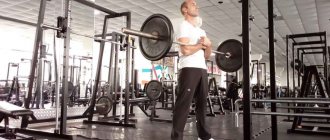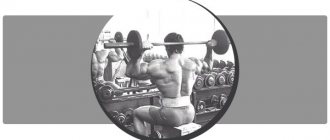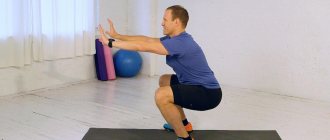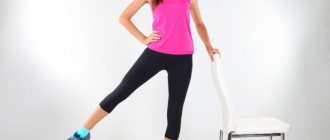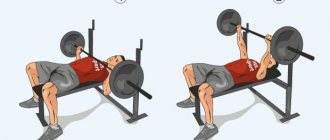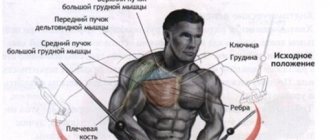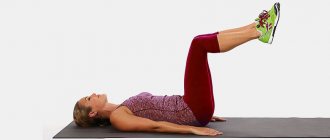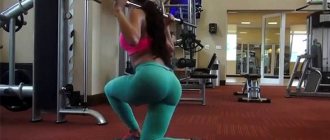Technique for doing squats in a machine
You can perform the exercises using a machine or using a barbell. For hack squats, the technique is designed specifically for both cases.
The hack squat machine has the same name. It consists of a steel base and a platform for installing legs. Another platform moves along an inclined surface, on which the athlete sits. As accessories and additional components there are forms for convenient installation of the shoulders.
As with most types of squats, the work involves the quadriceps, hamstrings, adductors/abductors and glutes.
Exercise technology:
- weight is selected by changing the number of discs on the bar;
- the athlete stands on the Hackenschmidt machine, placing his feet on the platform and pressing tightly against the machine;
- the gaze should be directed forward, the back is slightly arched, the shoulders are straightened, the feet are spread apart parallel to each other;
- the load is grasped tightly with straight arms and lowered down to the position of the thighs parallel to the floor, inhale;
- during exhalation, the bar rises smoothly, the legs straighten at the knees.
Beginners are advised to start squats with 3 sets of 8 reps on a hack machine, and then gradually increase the frequency count. During movement, the emphasis should be directed not on the toes, but on the heels. This increases efficiency and reduces the risk of straining the foot muscles.
If there are any problems with the muscles of the legs or buttocks, or a person leads a sedentary lifestyle, then it is recommended that you first familiarize yourself with squats using the Bubnovsky method.
Why do squats in the simulator?
- If you have not squatted with a barbell before, then the Hackenschmidt squat is a convenient and simple option. The reason is simple - your back is not ready to hold the barbell, but it can easily cope if you leave all the load to your legs. And lean your back against the back of the exercise machine.
- If you have a sore lower back. In this case, squats in the machine will take the load off the vulnerable lower back. Unfortunately, if your knees hurt, then such an exercise will be painful and dangerous, we will talk about this later.
- Thanks to the fact that you stand steadily in the machine, you can change the position of your legs in any convenient way. This means you can work different parts of the leg muscles.
Technique for performing hack squats using a barbell without a machine
The exercises can be performed without using a hack machine.
- the required weight of the bar is set;
- a person sits down and grabs a sports instrument from above;
- during the press, keep your arms and back straight;
- the athlete slowly rises, holding a load in his hands until his knees are fully straightened;
- Hack squats are done with a barbell until the thighs and shins form a right angle.
Squats with a barbell are repeated a fixed number of times in several approaches.
perform the exercise in a controlled manner throughout the entire trajectory of movement
Features of the leg press
The main difference between the hack machine and the Smith machine and regular barbell squats is that it allows you to remove the load from the lower back (lower back), but at the same time keep the load on the legs almost unchanged.
That is, this exercise machine is a “lifesaver” for those who have injuries or problems with the spine, lower back, or simply do not have the opportunity to exercise their lower back today.
It is also worth noting that during regular barbell and Smith machine squats, the lower part of the rectus abdominis muscle (abs) is involved in the work much more than when lifting weights in a hack machine. But in this simulator you can focus the load on specific muscle surfaces, for example, on the outer and inner parts of the thigh biceps. See also the exercise Romanian barbell deadlift.
Many may object: “This can be done with barbell squats or a Smith machine!” I wonder if you can do this with heavy weights? No. But in a hack machine this is possible.
In addition to all of the above, this simulator allows the athlete to train with heavy weights without the support of partners, which cannot be done with regular squats or when working on Smith.
Benefits of hack squats
Squats, developed according to the method of Georg Hackenschmidt, are popular among athletes due to a number of advantages.
- Suitable for girls and men.
- Simple training technology. There is no need to learn the technique, look for the center of gravity and train to do a squat.
- Independent choice of cargo weight. During the Hackenschmidt squat, the back and spine do not experience much stress, so you can safely take on a lot of weight. The main thing is not to overdo it.
- Working out individual muscles. With the correct position of the legs, you can distribute the load to the necessary areas of the legs.
- Possibility to do without coach insurance. There is no need to control the athlete, since the machine has stoppers.
- Low chance of injury.
- Effectiveness tested by many experienced bodybuilders.
Leg workouts including hack squats
Attention!
It has been proven that working to failure leads to a significant drop in results and working weights. The reason is that a clogged muscle is not able to be saturated with oxygen in the required amount, blood circulation is disrupted, and therefore the supply of nutrients is limited. This causes a slowdown in the development of muscle fibers and a significant setback in the training process. To get back in shape, an athlete must work limitedly on small weights for several weeks to a month. Maintaining a high tempo and loads with clogged muscles often leads to serious injuries - ruptures and stretching of tissues.
Foot placement options
The position of the legs determines which muscles the exercises are aimed at. There are 4 installation options in total.
- The feet are on the lower edge of the platform. The emphasis is on the front of the thighs.
- The legs are placed in the center and next to each other. This is how the lateral bundle of the quadriceps muscle is pumped.
- The feet are brought together and located at the upper edge of the platform. The exercises work the buttocks and hamstrings.
- The legs are spread apart at shoulder width, the toes pointing in different directions. The hip adductors feel the load during squats.
Features of the exercise
The main feature of squats in a hack machine is the complete fixation of the spine. The lower back is constantly pressed against the back and is unable to move or bend. This eliminates axial loads and relieves the spine.
Extension of the legs occurs primarily due to the work of the knee joint, and secondly due to the work of the hip joint. The exercise effectively loads the quadriceps, hamstrings and glutes.
The basic rule for performing hack squats is the correct placement of the feet on the platform. Your feet should be placed so that your knees do not go beyond the line of your toes when performing squats. Those. The feet should be placed closer to the edge of the platform.
With this position, breaking negative stresses will not occur in the knee joint, and the load will shift from the joint to the leg muscles.
It is worth saying that another factor in setting up this exercise is the width of the feet and the turn of the toes. When your feet are set narrowly (shoulder-width apart or narrower), you load the outer parts of the quadriceps. With a wide one, the emphasis shifts to the inner parts of the quadriceps and adductor muscles of the thigh.
Reverse hack squats
Exercises performed facing the machine are called reverse hack squats. In this case, the emphasis is placed on the gluteal muscles and the back of the thigh. They are performed in exactly the same way as the frontal ones, only with the body position rotated 180 degrees. Reverse hack squats are popular among bodybuilders and serious athletes.
If your knees give way from any weight, this exercise is not for you, first strengthen the stability of your knee joints.
Hack squats: what muscles work?
Hackenschmidt squats work on lower body development. They work the quadriceps - the quadriceps muscles that form the lateral and front surfaces of the thigh.
The quadriceps include four muscle bundles. These include the vastus lateralis, vastus intermedius, vastus medialis and rectus femoris. They stabilize the knee joint when the body is standing still, as well as when walking, running, jumping, bending and straightening the legs, and climbing stairs.
These muscles form the appearance of the thighs from the front and sides. The extent to which they are developed affects the athlete's strength level, overall physical condition and endurance.
By changing the technique of performing the exercise, you can vary the load on the outer and inner thighs. Also involved in squats are the abductor and adductor muscles of the thigh, the muscles of the buttocks, as well as synergists - the abdominal muscles and calf muscles.
Common hack squat mistakes
Despite the simplicity of the technique, athletes can make mistakes when performing squats in a hack machine.
The most common problems causing muscle pain and discomfort:
- incorrect breathing technique;
- performing exercises without warming up;
- the load is too heavy;
- abduction and extension of the knees;
- knees extend beyond toes;
- feet are not firmly pressed to the floor or platform;
- sudden drops or rises;
- squat too low;
- the gaze is directed downwards;
- the back and arms are in a crooked position.
Pros and cons of the hack squat
Typically, such questions are asked by people who study without a coach or with an inexperienced instructor. The free weight squat is fundamentally different from the hack machine in terms of biomechanics. In the squat, the weight of the barbell is distributed relatively evenly between the back and hips, especially in a technique that is safe to lift.
In a hack machine, it completely puts pressure on the shoulders, is projected onto the hips and puts quite a significant load on the knees.
The pros and cons of gakka can be summarized as follows:
- The variation is good for bodybuilding purposes. Allows you to load your legs with reduced “recoil” to the back, and get a fairly high-quality workout without the use of huge weights and the metabolic stress that accompanies such practice;
- The exercise can be used for those who are trying to master the squat with a vertical back, but cannot maintain balance with a barbell placed on top of the trapezius. At the same time, such a person can bend his hips and knees in principle, and sit in a full squat with a low barbell;
- The movement is suitable for those who need something to “finish off” their legs after regular squats, but the leg press is not suitable due to an unstable lower back position or some other similar factor;
- The machine is considered safer for performing drop sets and supersets, but is not intended for squatting with rubber shock absorbers. Although for a version of the squat with a rubber shock absorber around the hips, the hack is more suitable than the barbell, as it allows you to activate the hip;
- A significant disadvantage of Hakka is that it cannot replace squats with a barbell on the back and chest, but it is often used as a replacement, so people who practice such things rarely achieve significant progress. They may suffer both because of their ignorance and because the trainer convinced them of the need to “isolate the legs and exclude the back from the movement.” Let us remind you that you should do this only after your back muscles have strengthened. It is absolutely not necessary to perform Hakka squats with huge weights, the same applies to the barbell. But harmonious development of the body is achieved only by combinations of basic movements with free weight and exercises in simulators.
Security Recommendations
During squats, there is a risk of injury to the knee joint. That is why it is recommended to warm up well before starting classes. A 10-minute warm-up will help bring your muscles into working condition.
If you have problems with your back or knees, you should use elastic bandages or special belts. It is worth paying attention to shoes that should have a flat, hard sole.
The exercises must be performed strictly according to the rules. The hack squat machine must first be studied to understand how its functionality works. There is no need to lower your head, and if pumping takes place on a simulator, then your back should be straight and not come off the machine. You don't need to go lower than your thighs parallel to the floor.
Inclusion in the program
Hack machine is a simulator. Its specificity is to provide auxiliary effects:
Due to these features, the recommended number of repetitions is 8–12 with 3–4 approaches. This is the optimal ratio. If we talk about the frequency of doing squats in a hack machine, then it all depends on the intensity of the training and its system itself. For beginners, when visiting the gym 3 times a week, it is advisable to devote 1 workout to exercises in a hack machine.
You should adjust the weight (pancakes worn on the exercise machine) based on your actual capabilities and well-being. For the first period, the optimal load will be one that, when performed 10 repetitions per set, will produce slight muscle numbness.
Increasing the load should be done after the working weight becomes too light. However, you should not add more than 20 kg.
Load dosage
The advantage of using a hack machine is the ability to squat with more weight. But you shouldn’t test the limit every time using the pyramid system (when the athlete starts with small weights and gradually reaches the maximum - bench press 1 time and back down to a small load). Also, you don't need to do the maximum number of repetitions, which will lead to clogged muscles.
The leg press in a hack machine is great as an addition to basic exercises, and is partially a replacement for them. For example, if an athlete has put a lot of stress on his back, done deadlifts with a lot of weight or for a number of repetitions, then in order not to strain the back muscles, it is completely better to replace squats with a barbell with working in a hack machine.
What can replace hack squats?
To strengthen and increase the quadriceps muscles, exercises with a barbell, body bar and dumbbells are suitable. Exercises can be performed while holding a load on your shoulders or in your hands.
In addition to squats, lateral lunges are an alternative option. In this case, the angle of prolapse determines which muscle group is loaded. Forward bends with a barbell are also popular. During execution, the load on the muscles of the thighs and buttocks is felt.
Hack squats and a machine for this purpose are one of the most effective types of exercises for pumping up the quadriceps muscle. They can be easily done in the gym or at home with a barbell. The most important thing is to follow safety rules and choose the optimal weight for the load, and then the result will not be long in coming.
The benefits and harms of hack squats
Squats in the Hackenschmidt simulator have no negative effects on the musculoskeletal system and, if the exercise is performed correctly in compliance with the technique and safety rules, it is absolutely not dangerous and cannot harm the athlete. But this simulator brings enormous benefits to the development of an athlete’s muscles.
- Firstly, it removes the load on the spine. This exercise will be an ideal training option for an athlete with a spinal injury.
- Secondly, the hack machine can load any muscle in the thighs. You can emphasize the load by placing your feet on the platform of the simulator. You can also train your calf muscles using the Hackenschmidt simulator.
- Thirdly, the hack machine is perfect for developing strength, thanks to minimizing the load on the spinal column and the presence of safety elements that allow you to stop the workload in an emergency.
